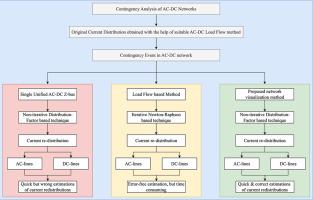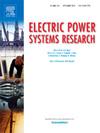用于交直流网络突发事件分析的基于交流 Z 总线的配电因子
IF 3.3
3区 工程技术
Q2 ENGINEERING, ELECTRICAL & ELECTRONIC
引用次数: 0
摘要
交直流网络与其他传统电力网络一样,容易受到有意和意外突发事件的影响。由于所提供网络的统一阻抗矩阵形式复杂,基于 Z 总线的经典突发事件分析方法无法理解交直流网络。因此,从统一的复杂 Z 总线中获得的分布系数可显示直流线路的复杂电流流向。因此,需要寻找一种替代方法来发现突发事件后的后果。本研究提出了一种简化的方法,可视化给定交直流网络的等效交流网络。交流等效网络采用原始交直流网络,并使用两个并行交流网络重新创建,以获得所需的分布系数。根据所建议技术的线性特征,通过对并联网络应用叠加规则,可确定原始交直流网络的最终电流/功率分布。这样,就可以利用标准交流突发事件分析方法完成交直流网络的稳态突发事件分析。在 10、13 和 66 个母线的交直流网络中取得的令人鼓舞的结果验证了所建议的方法。本文章由计算机程序翻译,如有差异,请以英文原文为准。

An AC Z-bus-based distribution factors for contingency analysis of AC–DC networks
The AC–DC networks are susceptible to deliberate and unforeseen contingencies, much like any other traditional power network. Due to the complex form of the unified impedance matrix derived for the provided network, the classic Z-bus-based contingency analysis approach cannot comprehend the AC–DC network. The distribution factors thus obtained from a unified complex Z-bus lead to an indication of the flow of complex current for DC lines. Therefore, an alternative method to discover post-contingency consequences is looked for. A streamlined approach for visualizing an equivalent AC network for the given AC–DC network has been proposed in this work. The AC-equivalent network takes the original AC–DC network and recreates it using two parallel AC networks to get the requisite distribution factors. The ultimate current/power distributions of the original AC–DC network can be determined by applying the superposition rule to the parallel networks, by the linear characteristics of the suggested technique. With this, the standard AC-contingency analysis method to complete the steady-state contingency analysis for the AC–DC network can be utilized. The proposed approach has been validated by the encouraging outcomes achieved for AC–DC networks with 10, 13, and 66 buses.
求助全文
通过发布文献求助,成功后即可免费获取论文全文。
去求助
来源期刊

Electric Power Systems Research
工程技术-工程:电子与电气
CiteScore
7.50
自引率
17.90%
发文量
963
审稿时长
3.8 months
期刊介绍:
Electric Power Systems Research is an international medium for the publication of original papers concerned with the generation, transmission, distribution and utilization of electrical energy. The journal aims at presenting important results of work in this field, whether in the form of applied research, development of new procedures or components, orginal application of existing knowledge or new designapproaches. The scope of Electric Power Systems Research is broad, encompassing all aspects of electric power systems. The following list of topics is not intended to be exhaustive, but rather to indicate topics that fall within the journal purview.
• Generation techniques ranging from advances in conventional electromechanical methods, through nuclear power generation, to renewable energy generation.
• Transmission, spanning the broad area from UHV (ac and dc) to network operation and protection, line routing and design.
• Substation work: equipment design, protection and control systems.
• Distribution techniques, equipment development, and smart grids.
• The utilization area from energy efficiency to distributed load levelling techniques.
• Systems studies including control techniques, planning, optimization methods, stability, security assessment and insulation coordination.
 求助内容:
求助内容: 应助结果提醒方式:
应助结果提醒方式:


